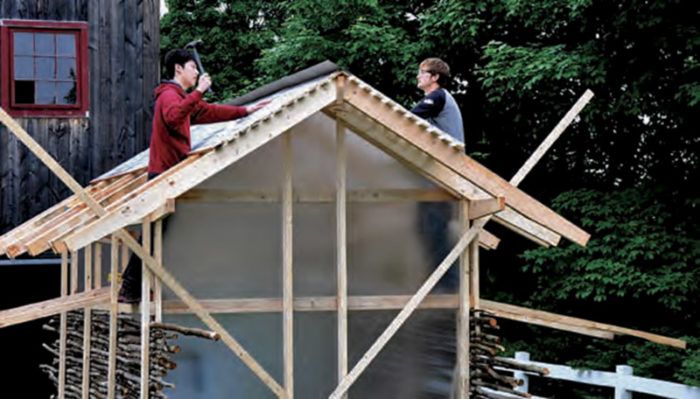Drawing Is Easy, Building Is Hard
A real-world relationship with building materials and processes makes architects better at their jobs.

By Keith Moskow, Robert Linn, and William Morgan
Each architect has a slightly different introduction to the trades. For example, one of the three of us grew up with an intimate knowledge of tools and construction provided by a father who was a builder, while another had never so much as built a tree-house floor (his father was a professor of art). While a building background is not necessarily superior to a design background, we have found that the act of building something provides a designer with valuable insight that can’t be learned in a classroom. Architects learn about materials and tools in a theoretical setting, but a real-world relationship with building materials and processes does, in fact, make architects better able to understand and visualize the construction of a structure, and therefore makes them better at their job.
In 2009, we designed and built a family retreat space for ourselves. The project was a departure from our normal process, which is to design on paper and then turn the drawings over to a builder to be realized. Instead, we schlepped the materials to the site, hoisted walls and beams, and nailed everything together ourselves. In doing so, we came closer to understanding what both craftsmen and contractors have already learned—or perhaps instinctively know—about construction: Drawing is easy, but building is hard. Not only is the act of building physically demanding, but an architect’s designs can require complex building techniques that may not be within the builder’s skill set. We realized that the process of construction should be considered by an architect at least as highly as the finished product. This was the genesis of Studio North.
Design/build boot camp
Studio North, a workshop that we began in 2011, provides an introduction to the world of building for would-be architects. The intensive program, in which young women and men conceptualize, design, and build an entire structure in less than a week, is unique in some ways, though many agree that the hands on experience of building is invaluable for designers. The Yale School of Architecture, Auburn University’s Rural Studio in Alabama, and the University of Utah’s Design Build Bluff all offer construction experience to graduate architecture students. But Studio North differs as a voluntary experience for undergraduate students who are contemplating a career in architecture—many of whom have never held a hammer, never poured a concrete foundation or framed a wooden building, and never experienced the joy of a trip to a lumberyard.
We know that the students who join us each summer for what is essentially a design/build boot camp are not likely to become builders. Our intention is to give these aspiring architects a taste of construction, bridging the gap between the visualization of an idea and the physical completion of a structure. Designers create better architecture if they understand first hand how buildings are made, and this is the goal of Studio North.
Keith Moskow, FAIA, Robert Linn, AIA, and William Morgan are frequent collaborators at Boston-based Moskow Linn Architects.
For more photos and information on how Studio North is teaching future architects how to build, click the View PDF button below.
Fine Homebuilding Recommended Products
Fine Homebuilding receives a commission for items purchased through links on this site, including Amazon Associates and other affiliate advertising programs.

Musings of an Energy Nerd: Toward an Energy-Efficient Home

All New Bathroom Ideas that Work

Graphic Guide to Frame Construction

























